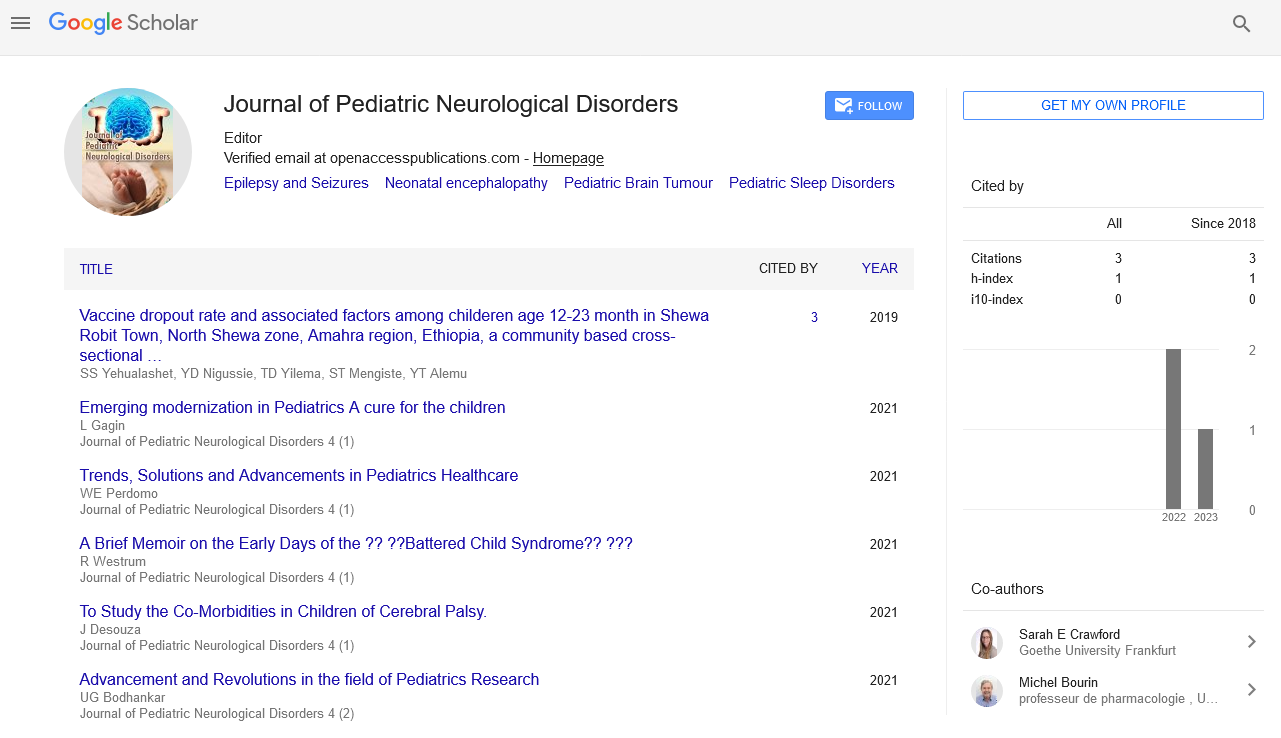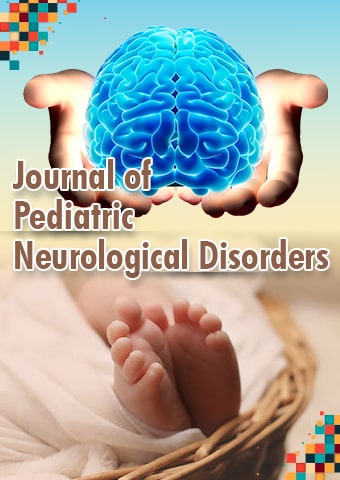Mini Review - Journal of Pediatric Neurological Disorders (2023) Volume 6, Issue 4
Childhood Traumatic Brain Injury
Selena Orman*
Department of Neurophysiology, Guven Hospital, Turkey
Department of Neurophysiology, Guven Hospital, Turkey
E-mail: selenaorman5@yahoo. com
Received: 01-Aug-2023, Manuscript No. pnn-23-111201; Editor assigned: 07-Aug-2023, PreQC No. pnn-23- 111201(PQ); Reviewed: 14- Aug- 2023, QC No. pnn-23-111201; Revised: 22-Apr-2023, Manuscript No. pnn-23-111201; Published: 31-Aug-2023, DOI: 10.37532/ pnn.2023.6(4).94-96
Abstract
The primary cause of death and impairment in children is traumatic brain injury (TBI). Children's physical abilities, age-related anatomical and physiological changes, the pattern of injuries, and the difficulties in neurological examination in children all contribute to pediatric TBI's unique characteristics that set it apart from adult TBI. There has been a lot of work done to understand the pathophysiology of the specific pathological response that TBI in children appears to elicit, along with the different neurological symptoms that go along with it. Additionally, recent technical developments in pediatric TBI diagnostic imaging have made it easier to make a precise diagnosis, choose the right course of action, avoid complications, and forecast long-term outcomes. This article presents a review of current studies that are pertinent to significant issues in pediatric TBI and also discusses recent particular subjects. The pathogenesis, diagnosis, and age-appropriate acute therapy of pediatric TBI are all critically updated in this review.
Keywords
Traumatic brain injury • Physiological changes • Neurological symptoms • Recent technical developments • Acute therapy
Introduction
Children's deaths and disabilities are most frequently caused by Traumatic Brain Injury (TBi). Although the variety of traumatic injuries to the scalp, skull, and brain caused by TBi in children are similar to those in adults, their aetiology and treatment are different. The disparities can be attributed to age-related anatomical change, injury mechanisms dependent on a child's physical prowess, and the challenge of evaluating paediatric populations' brain health. Due to its extensive vascularization, the scalp may experience fatal blood loss. In a newborn, infant, or toddler, even a minor loss of blood volume can cause hemorrhagic shock, which can happen even when there is no obvious outward bleeding. Children are therefore thought to display a particular pathological response to brain damage and associated neurological symptoms. Improvements in diagnostic imaging have raised the standard of care by making it easier for medical professionals to assess and identify children with TBi [1].
Epidemology
Children's deaths from unintentional causes are the most common. Brain injuries are the most likely of all severe injuries to cause death or lifelong impairment. Studies from the American Centres for Disease Prevention and Control have produced a lot of information about paediatric tuberculosis. An estimated 475,000 Americans between the ages of 0 and 14 get TBi each year; up to 90% of these individuals recover at home, 37,000 are hospitalised, and 2,685 individuals may away as a result of their injuries [2].
According to an age-specific study conducted that same year, children aged 0 to 4 years had the highest rate of emergency consultations (1,035 per 100,000), and 80 of those children were hospitalised. Children under the age of 4 die from traumatic injury at a rate of 5 per 100,000 per year. The greater rate of traumatic injury fatalities among younger children may be due to the prevalence of abuse-related wounds among newborns and young children. 1) Adolescents were the age group most frequently hospitalised for TBi (129 per 100,000) [3].
Characterization of injury on behalf of age
Depending on the degree of the trauma, children with brain injuries present in a very diverse clinical manner. To determine the severity of brain injuries and to determine consciousness, doctors frequently utilise the Paediatric Glasgow Coma Scale (PGCS). Neurological abnormalities are typically discovered at the scene of the accident, and newly emerging clinical symptoms may signal future development of pathological alterations caused by head traumas and should be thoroughly explored. Paediatric brain injuries have special biomechanical characteristics because of a mix of increased plasticity and deformity, which causes external pressures to be absorbed differently than in adults. Because open sutures act as joints and the baby skull is less rigid, it can move somewhat in reaction to mechanical stress [4].
Diagnosis
Extra-parenchymal injury, such as epidural hematoma, subdural hematoma, subarachnoid haemorrhage, and intraventricular haemorrhage, as well as intra-parenchymal injury, such as Diffuse Axonal Injury (DAi) and intracerebral haemorrhage, as well as vascular injury, such as vascular dissection, carotid artery-cavernous sinus fistula [5].
Treatment
Using sedative
To achieve the amount of anaesthesia required for invasive operations, such as airway management, iCP control, to synchronise respiratory attempts with the ventilator, and anxiety alleviation during diagnostic imaging, sedatives and analgesics are essential for general care of all TBi children. Children with severe TBi are typically treated with a combination of opioids and benzodiazepines to reduce their pain and drowsiness. Due of propofol infusion syndrome, it is illegal to provide propofol to children continuously. Neuromuscular blockade is used, nonetheless, to enhance compliance with mechanical ventilation, lower metabolic demand, and stop shivering in children with severe TBi [6].
CSF drainage
In order to treat elevated iCP, cerebrospinal fluid drainage is performed to reduce the volume of the cerebral vault's contents. To remove the CSF, an external ventricular drain is frequently employed. When there is refractory intracranial hypertension, a working External Ventricular Drainage (EVD), open basal cisterns, and no sign of a mass lesion or shift on imaging examinations, the installation of a lumbar drain may be taken into consideration. An increased risk of consequences from infection and haemorrhage may be linked to therapy [7 , 8].
Hyperventilation
By reducing CBF and constricting the arterioles in the brain, hyperventilation lowers the iCP. Within 48 hours of damage, a significant drop in CBF is anticipated, and hyperventilation may result in subclinical cerebral ischemia and a decline in cerebral oxygenation. As a result, extreme hyperventilation ought to be avoided. Patients with refractory intracranial hypertension are advised to practise mild hyperventilation (PaCo2, 30-35 mmHg). In such cases, End- Tidal Carbon Dioxide (ETCo2) monitoring or arterial blood gas measurement will be helpful to track and stop further CBF reduction [9, 10].
Conclusion
Each stage of management must be approached from a multidisciplinary perspective for the best care of a baby or child with TBi. To prevent pathophysiological harm to the growing brain after the initial evaluation, timely diagnosis, multimodal monitoring, and titrated therapy of intracranial hypertension are required. The management of paediatric TBi presents difficulties due to variations in the fundamental processes of damage. In the near future, more medical data will be available on the development of neural damage and healing in paediatric TBi.
References
- Gill D, Veltkamp R. Dynamics of T cell Responses after Stroke. Current Opinion in Pharmacology. 26, 26-32 (2016).
- Yilmaz G, Arumugam TV, Stokes KY et al. Role of T Lymphocytes and Interferon-Gamma in Ischemic Stroke. Circulation. 113, 2105-2112 (2006).
- Engelhardt B, Ransohoff RM. The T Cell Code to Breach the Blood-Brain Barriers. Trends Immunol. 33, 579-589 (2012).
- Ley K, Kansas GS. Selectins in T-Cell Recruitment to Non-Lymphoid Tissues and Sites of Inflammation. Nat Rev Immunol. 4, 325-336 (2004).
- Matsumoto M, Shigeta A, Furukawa Y et al. CD43 Collaborates with P-Selectin Glycoprotein Ligand-1 to Mediate E- Selectin-Dependent T cell Migration into Inflamed Skin. J Immunol .178, 2499-2506 (2007).
- Alon R, Feigelson SW. Chemokine-Triggered Leukocyte Arrest: Force- Regulated Bi-Directional Integrin Activation in Quantal Adhesive Contacts. Curr Opin Cell Biol. 24, 670-676 (2012).
- Benakis C, Llovera G, Liesz A. The Meningeal and Choroidal Infiltration Routes for Leukocytes in Stroke. Ther Adv Neurol Disord .11, 1756286418783708 (2018).
- Yang C, Hawkins KE, Doré S et al. Neuroinflammatory Mechanisms of Blood-Brain Barrier Damage in Ischemic Stroke. Am J Physiol Cell Physiol. 316, C135–C153 (2019).
- Lauer AN, Tenenbaum T, Schroten H et al. The Diverse Cellular Responses of the Choroid Plexus During Infection of the Central Nervous System. Am J Physiol Cell Physiol. 314, C152-C165 (2018).
- Clarkson BD, Ling C, Shi Y et al. T Cell- Derived Interleukin (IL)-21 Promotes Brain Injury Following Stroke in Mice. J Exp Med. 211,595–604 (2014).
Indexed at, Google Scholar, Crossref
Indexed at, Google Scholar, Crossref
Indexed at, Google Scholar, Crossref
Indexed at, Google Scholar, Crossref
Indexed at, Google Scholar, Crossref
Indexed at, Google Scholar, Crossref
Indexed at, Google Scholar, Crossref
Indexed at, Google Scholar, Crossref
Indexed at, Google Scholar, Crossref

